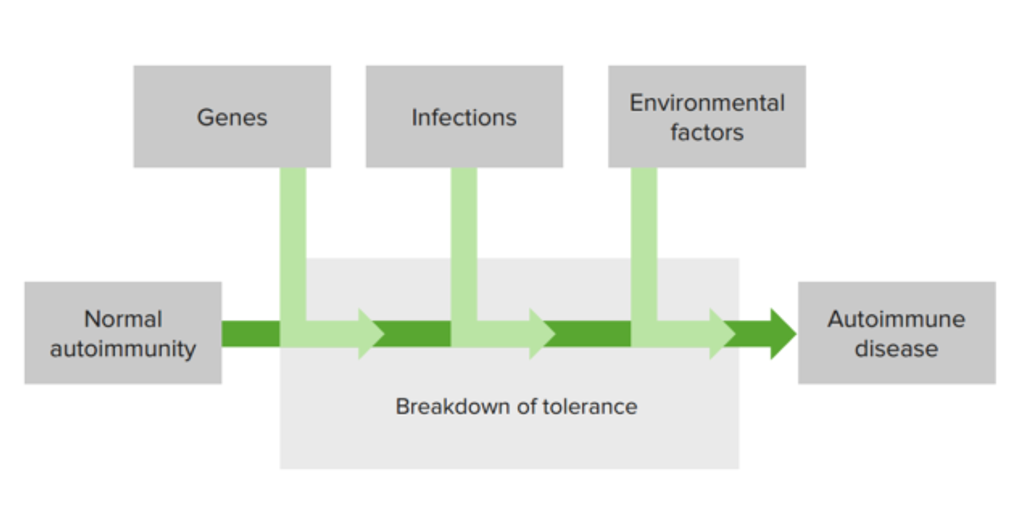Playlist
Show Playlist
Hide Playlist
Autoimmune Diseases: Types
-
Slides Autoimmune Disease.pdf
-
Reference List Immune System.pdf
-
Download Lecture Overview
00:01 I’m now going to turn to a number of examples of autoimmune diseases. 00:08 And you may be wondering, well what are the most common autoimmune diseases? Well actually there are hundreds of different autoimmune diseases. 00:15 But listed here are the ones with the highest prevalence. 00:20 These are typical prevalence, they will vary in different populations depending on the genetic makeup of different ethnicities. They also vary somewhat-- where you’re living in the world. But these are kind of typical prevalences for these types of autoimmune disease. So Grave’s disease which is a hyperthyroidism, the autoimmune process leads to a overactive thyroid gland. About one in a hundred individuals develop Grave’s disease. Rheumatoid arthritis which involves the inflammation of joints, about 0.9% of individuals. 00:57 Hashimoto’s disease which is also a disease affecting the thyroid gland just like Grave’s disease, but actually has the opposite effect. 01:07 It’s a destructive thyroiditis, an inflammation of the thyroid, leads to hypothyroidism - an underactive thyroid. 01:14 And this occurs in around about 0.5% of individuals. As I said, these figures, they’re just ball park figures. They’ll vary a little bit in different studies and between different groups of people. Sjogren’s syndrome leads to reduced secretory gland function, occurs in about 0.4% of individuals. 01:33 Pernicious anemia which is vitamin B12 deficient anemia, in around about 0.2% of individuals. Multiple sclerosis which results in demyelination - 0.1% Ankylosing spondylitis which we’re mentioning a couple minutes ago causes inflammation of the spine and sacroiliatic joints, about 0.1% of individuals suffer from ankylosing spondylitis. Type I diabetes leading to hyperglycemia, again around about 0.1% of individuals. 02:05 And systemic lupus erythematosus which can have multiple consequences affecting the skin, heart, joints, lungs, kidney and brain. Again around about 0.1% of people as a rough ball park figure suffer from SLE. 02:21 Looking at some of the target organs and tissues of autoimmune diseases, erythrocytes or platelets are affected in autoimmune hemolytic anemia, in pernicious anemia and in autoimmune thrombocytopenic purpura. 02:37 Kidneys and lungs in Goodpasture’s syndrome. 02:42 Endocrine glands in Hashimoto’s thyroiditis, in Grave’s disease and in type I diabetes. 02:49 The first two of those affecting the thyroid gland and type I diabetes of course affecting the pancreas. 02:54 The musculoskeletal system is affected in rheumatoid arthritis and in an autoimmune condition called acute rheumatic fever. 03:03 Multiple tissues and organs are affected in systemic lupus erythematosus; as its name suggests, systemic - it affects the whole of the body. 03:13 The nervous system in multiple sclerosis, Guillain-Barre syndrome and myasthenia gravis. 03:19 And the GI tract in celiac disease.
About the Lecture
The lecture Autoimmune Diseases: Types by Peter Delves, PhD is from the course Hypersensitivity and Autoimmune Disease. It contains the following chapters:
- Overview of the Major Autoimmune Diseases
- Some Target Organs and Tissues of Autoimmune Diseases
Included Quiz Questions
Which of the following statements regarding autoimmune diseases is INCORRECT?
- Graves disease mainly causes hypothyroidism.
- Multiple sclerosis is a demyelinating disease.
- Type I diabetes causes hyperglycemia.
- Pernicious anemia is mainly caused by a deficiency of vitamin B12.
- Sjorgren's syndrome may cause dry mouth and eyes.
Which of the following diseases mainly affects the neuromuscular junction?
- Myasthenia gravis
- Celiac disease
- Type I diabetes
- Goodpasture's syndrome
- Acute rheumatic fever
Customer reviews
5,0 of 5 stars
| 5 Stars |
|
5 |
| 4 Stars |
|
0 |
| 3 Stars |
|
0 |
| 2 Stars |
|
0 |
| 1 Star |
|
0 |




